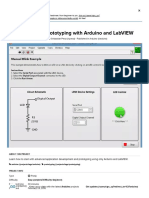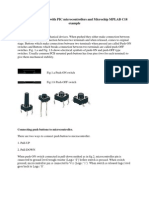100%(1)100% found this document useful (1 vote)
391 viewsUsing Push Buttons
Push buttons are mechanical devices that either make or break an electrical connection between two terminals when pressed or released. There are two types - push-on switches that make a connection and push-off switches that break a connection. A problem with push buttons is switch debouncing, which is caused by the mechanical contacts oscillating briefly when the button is pressed or released. This can cause a single button press to register as multiple presses. Software or hardware debouncing methods like delays, interrupts, or RC circuits are used to filter out the oscillations and produce a clean digital signal.
Uploaded by
Niño Galos JuanilloCopyright
© © All Rights Reserved
Available Formats
Download as PPT, PDF, TXT or read online on Scribd
100%(1)100% found this document useful (1 vote)
391 viewsUsing Push Buttons
Push buttons are mechanical devices that either make or break an electrical connection between two terminals when pressed or released. There are two types - push-on switches that make a connection and push-off switches that break a connection. A problem with push buttons is switch debouncing, which is caused by the mechanical contacts oscillating briefly when the button is pressed or released. This can cause a single button press to register as multiple presses. Software or hardware debouncing methods like delays, interrupts, or RC circuits are used to filter out the oscillations and produce a clean digital signal.
Uploaded by
Niño Galos JuanilloCopyright
© © All Rights Reserved
Available Formats
Download as PPT, PDF, TXT or read online on Scribd
You are on page 1/ 29
Using Push Buttons
Push buttons are cheap mechanical
devices. When pushed they either make
connection between two terminals or
break connection between two terminals
and when released, comes to original
stage. Buttons which make connections
between two terminals when pressed are
called Push-ON switches and Buttons
which breaks connection between two
terminals are called push-OFF switches.
Usually common PCB mounted push
buttons has four pins (two for each
terminal) to give them mechanical
stability.
There are two ways to connect push
button to a circuit
1. Pull-UP
2. Pull-DOWN
When push-ON switch connected in
pull-down method, logic gate pin is
connected to ground level through
resistor (Logic ‘0’) before switch is
pressed. When switch pressed, logic
gate pin is connected to Vcc (Logic
‘1’). When switch is released logic
level goes back to Logic ‘0’.
Push button connected as Pull-Down
Push button connected as Pull-UP
Switch De-bouncing.
Operation of push button switch is
simple; it either makes connection or
breaks connection between its two
terminals. But wait, there is problem.
When switch is pressed there is short
period of time where oscillation
occurs.
Oscillation is random and usually less
than 10mS for general PCB mounted push
button switches known as micro
switches. This problem occurs because
mechanical contacts of switchs are not
perfect and nature of electricity. Different
speed of pushing switch is also affects
this problem. This phenomenon is called
switch de-bouncing.
If we ignore this de-bouncing when
creating circuit digital electronics or
microcontrollers, program may
behave in unexpected way or, single
button press may produce more than
one output pulse. To overcome this
issue we introduce small delay in our
program or create hardware
debounce
For example, when we detect switch
press (logic change, say 0 to 1) in
program, we wait small time (usually
about 10mS) and again check status
of switch, now if we encounter logic 1
again this means logic status of
switch is changed from 0 to 1, which
is called switch pressed.
Above figure shows timing diagrams
of switch pressing. Note the time
periods t1 to t2, t3 to t4 are
bouncing. This is what you see if you
examine switch press in oscilloscope.
This type delay method of de-
bouncing has some disadvantages.
Mainly the delay time of 10mS or so
iis idling time for MCU and for some
applications this time is too much and
unacceptable.
Much better way to do debouching is
using interrupts. For example we use
10mS timer interrupt which will
branch our program to switch scan
routine where we will quickly scan
status of all of our switches and
record them in array or variables.
Then after another 10uS same thing
will happen. The idea here is simple.
For every 10ms time, each push
button state will be checked and
compared to the previous states
recorded. This will uncover rising and
falling edges of signal.
If there is no change compared to
previous state of one switch, it is
obvious, that switch is not pressed (or
not changed) its status. In case of
change from 0 to 1, rising edge detected
and change from 1 to 0, falling edge
detected. If next 3 or 4 checks do not
detect any change in new logic state, we
are certain that switch is pressed (or
released).
Hardware Debouncers
Figure below shows the classic
debounce circuit. Two cross-coupled
NAND gates form a very simple Set-
Reset (SR) latch. The design requires
a double-throw switch. Two pull-up
resistors generate a logic one for the
gates; the switch pulls one of the
inputs to ground.
With the switch in the position shown the
upper gate's output will be a one, regardless
of the value of the other input. That and the
one created by the bottom pull-up resistor
drives the lower NAND to a zero . . . which
races around back into the other gate. If the
switch moves between contacts, and is for a
while suspended in the nether region
between terminals, the latch maintains its
state because of the looped back zero from
the bottom gate.
The switch moves a rather long way
between contacts. It may bounce
around a bit, but will never bang all
the way back to the other contact.
Thus, the latch's output is guaranteed
bounce-free.
An RC Debouncer
The SR circuit is the most effective of all
debouncing approaches. but it's rarely used.
Double-throw switches are bulkier and more
expensive than the simpler single-throw
versions. An awful lot of us use switches that
are plated onto the circuit board, and it's
impossible to make DP versions of these. So
ENGINEERs prefer alternative designs that
work with cheap single-throw switches.
Though complex circuits using
counters and smart logic satisfy our
longing for pure digital solutions to all
problems, from signal processing to
divorce, it's easier and cheaper to
exploit the peculiar nature of a
resistor-capacitor (RC) network.
Charge or discharge a capacitor
through a resistor and you'll find the
voltage across the cap rises slowly; it
doesn't snap to a new value like a
sweet little logic circuit. Increase the
value of either component and the
time lag ("time constant”) increases.
A simple circuit, surely, yet one that
hides a surprising amount of
complexity.
Suppose our fearless flipper opens
the switch. The voltage across the cap
is zero, but it starts to climb at a rate
determined by the values of R1, R2
and C. Bouncing contacts pull the
voltage down and slow the cap's
charge accumulation.
If we're very clever in selecting the
values of the components the voltage
stays below a gate's logic one level till
all of the whacking and thudding
ceases. (If the time constant is too
long, of course, the system won't be
responsive to fast switch actuations).
The gate's output is thus a pristine
bounce-free logic level.
You might also like
- DOMINION (2014-15) - Complete TV Series and LEGION Movie - 720p BluRay x264100% (1)DOMINION (2014-15) - Complete TV Series and LEGION Movie - 720p BluRay x2642 pages
- ACER Aspire E5-475G (Core I3-6006u) : Harga Estimasi DeskripsiNo ratings yetACER Aspire E5-475G (Core I3-6006u) : Harga Estimasi Deskripsi1 page
- Electronic Motors Part I - Brushless D.C. MotorsNo ratings yetElectronic Motors Part I - Brushless D.C. Motors12 pages
- Elan Ruskin Programming Forensic DebuggingNo ratings yetElan Ruskin Programming Forensic Debugging136 pages
- AntMiner S9 Hydro Server Installation GuideNo ratings yetAntMiner S9 Hydro Server Installation Guide21 pages
- Ingenico - Elite 790 - Installation Guide (2004!10!20) (FCCID - Io-485459) (GPRS) (Cdma)No ratings yetIngenico - Elite 790 - Installation Guide (2004!10!20) (FCCID - Io-485459) (GPRS) (Cdma)2 pages
- Microcontroller (AT89S52) Based Remote Notice Board Using GSMNo ratings yetMicrocontroller (AT89S52) Based Remote Notice Board Using GSM72 pages
- Dual Adjustable Power Supply Circuit LM317 LM387100% (1)Dual Adjustable Power Supply Circuit LM317 LM3874 pages
- Electronic Component: Adding Citations To Reliable SourcesNo ratings yetElectronic Component: Adding Citations To Reliable Sources26 pages
- Basic Electronics - College Algebra Course Manual100% (10)Basic Electronics - College Algebra Course Manual157 pages
- CS436 - Mobile Application Development: Dr. Usman Khan DurraniNo ratings yetCS436 - Mobile Application Development: Dr. Usman Khan Durrani38 pages
- At Commands For CDMA Modems Incl Qualcomm U300No ratings yetAt Commands For CDMA Modems Incl Qualcomm U300195 pages
- EC6401 Electronics Circuits II - Notes - Annaunivupdates100% (2)EC6401 Electronics Circuits II - Notes - Annaunivupdates96 pages
- Electronics for Beginners A Practical Introduction to Schematics Circuits and Microcontrollers 1st Edition Jonathan Bartlett - Download the ebook and explore the most detailed content100% (2)Electronics for Beginners A Practical Introduction to Schematics Circuits and Microcontrollers 1st Edition Jonathan Bartlett - Download the ebook and explore the most detailed content68 pages
- Hubs Are Used To Build A LAN by Connecting Different Computers in A Star/hierarchal NetworkNo ratings yetHubs Are Used To Build A LAN by Connecting Different Computers in A Star/hierarchal Network4 pages
- Easy System Prototyping With Arduino and LabVIEW - HacksterNo ratings yetEasy System Prototyping With Arduino and LabVIEW - Hackster10 pages
- Home Security System: Chun-Pai Jimmy Hsieh Yang CaoNo ratings yetHome Security System: Chun-Pai Jimmy Hsieh Yang Cao12 pages
- Investigation of the Usefulness of the PowerWorld Simulator Program: Developed by "Glover, Overbye & Sarma" in the Solution of Power System ProblemsFrom EverandInvestigation of the Usefulness of the PowerWorld Simulator Program: Developed by "Glover, Overbye & Sarma" in the Solution of Power System ProblemsNo ratings yet
- Control of DC Motor Using Different Control StrategiesFrom EverandControl of DC Motor Using Different Control StrategiesNo ratings yet
- Digital Audio Broadcasting: Principles and Applications of Digital RadioFrom EverandDigital Audio Broadcasting: Principles and Applications of Digital RadioWolfgang HoegNo ratings yet
- Connecting Push Buttons To MicrocontrollerNo ratings yetConnecting Push Buttons To Microcontroller1 page
- Using Push Buttons With PIC Microcontrollers and Microchip MPLAB C18 Example100% (2)Using Push Buttons With PIC Microcontrollers and Microchip MPLAB C18 Example4 pages
- Microprocessor Interfacing & Programming: Laboratory ManualNo ratings yetMicroprocessor Interfacing & Programming: Laboratory Manual7 pages
- Implementing Switch Debounce by Code in Embedded System DesignNo ratings yetImplementing Switch Debounce by Code in Embedded System Design3 pages
- Theory Lecture Week 4M MES Prof MuhibulNo ratings yetTheory Lecture Week 4M MES Prof Muhibul38 pages
- Spaulding Lighting Price Book Net 10-85No ratings yetSpaulding Lighting Price Book Net 10-8564 pages
- Teaching Receptive Skills (Reading + Listening)No ratings yetTeaching Receptive Skills (Reading + Listening)14 pages
- Major Technical Specifications: AP-2 AppendixNo ratings yetMajor Technical Specifications: AP-2 Appendix12 pages
- Sexual Sin and Sanctification Nov 29 2023No ratings yetSexual Sin and Sanctification Nov 29 20235 pages
- Unit 5 HRM in Retailing: 1. Societal ObjectivesNo ratings yetUnit 5 HRM in Retailing: 1. Societal Objectives20 pages
- Taxation: RC NRC RA Nraeb Nraneb SA On Taxable Income On Passive IncomeNo ratings yetTaxation: RC NRC RA Nraeb Nraneb SA On Taxable Income On Passive Income1 page
- VAM US Mid Cap USD Growth B Fund Fact Sheet - April 2020No ratings yetVAM US Mid Cap USD Growth B Fund Fact Sheet - April 20203 pages
- Student Exploration: Roller Coaster PhysicsNo ratings yetStudent Exploration: Roller Coaster Physics3 pages
- A Summer Internship Report On The Topic - FinancialNo ratings yetA Summer Internship Report On The Topic - Financial13 pages
- 5 Types of Fish Often Called As The 'Dragon Fish' by Eka RahmadhyNo ratings yet5 Types of Fish Often Called As The 'Dragon Fish' by Eka Rahmadhy3 pages
- The End of An Architectural Era (It's Time For A Complete Rewrite)No ratings yetThe End of An Architectural Era (It's Time For A Complete Rewrite)11 pages
- Policy On The Organization and Implementation of The Special Program in Journalism (SPJ)No ratings yetPolicy On The Organization and Implementation of The Special Program in Journalism (SPJ)19 pages
- DOMINION (2014-15) - Complete TV Series and LEGION Movie - 720p BluRay x264DOMINION (2014-15) - Complete TV Series and LEGION Movie - 720p BluRay x264
- ACER Aspire E5-475G (Core I3-6006u) : Harga Estimasi DeskripsiACER Aspire E5-475G (Core I3-6006u) : Harga Estimasi Deskripsi
- Ingenico - Elite 790 - Installation Guide (2004!10!20) (FCCID - Io-485459) (GPRS) (Cdma)Ingenico - Elite 790 - Installation Guide (2004!10!20) (FCCID - Io-485459) (GPRS) (Cdma)
- Microcontroller (AT89S52) Based Remote Notice Board Using GSMMicrocontroller (AT89S52) Based Remote Notice Board Using GSM
- Electronic Component: Adding Citations To Reliable SourcesElectronic Component: Adding Citations To Reliable Sources
- CS436 - Mobile Application Development: Dr. Usman Khan DurraniCS436 - Mobile Application Development: Dr. Usman Khan Durrani
- EC6401 Electronics Circuits II - Notes - AnnaunivupdatesEC6401 Electronics Circuits II - Notes - Annaunivupdates
- Electronics for Beginners A Practical Introduction to Schematics Circuits and Microcontrollers 1st Edition Jonathan Bartlett - Download the ebook and explore the most detailed contentElectronics for Beginners A Practical Introduction to Schematics Circuits and Microcontrollers 1st Edition Jonathan Bartlett - Download the ebook and explore the most detailed content
- Hubs Are Used To Build A LAN by Connecting Different Computers in A Star/hierarchal NetworkHubs Are Used To Build A LAN by Connecting Different Computers in A Star/hierarchal Network
- Easy System Prototyping With Arduino and LabVIEW - HacksterEasy System Prototyping With Arduino and LabVIEW - Hackster
- Home Security System: Chun-Pai Jimmy Hsieh Yang CaoHome Security System: Chun-Pai Jimmy Hsieh Yang Cao
- Software Defined Radio: The Software Communications ArchitectureFrom EverandSoftware Defined Radio: The Software Communications Architecture
- Investigation of the Usefulness of the PowerWorld Simulator Program: Developed by "Glover, Overbye & Sarma" in the Solution of Power System ProblemsFrom EverandInvestigation of the Usefulness of the PowerWorld Simulator Program: Developed by "Glover, Overbye & Sarma" in the Solution of Power System Problems
- Control of DC Motor Using Different Control StrategiesFrom EverandControl of DC Motor Using Different Control Strategies
- Digital Audio Broadcasting: Principles and Applications of Digital RadioFrom EverandDigital Audio Broadcasting: Principles and Applications of Digital Radio
- Using Push Buttons With PIC Microcontrollers and Microchip MPLAB C18 ExampleUsing Push Buttons With PIC Microcontrollers and Microchip MPLAB C18 Example
- Microprocessor Interfacing & Programming: Laboratory ManualMicroprocessor Interfacing & Programming: Laboratory Manual
- Implementing Switch Debounce by Code in Embedded System DesignImplementing Switch Debounce by Code in Embedded System Design
- Taxation: RC NRC RA Nraeb Nraneb SA On Taxable Income On Passive IncomeTaxation: RC NRC RA Nraeb Nraneb SA On Taxable Income On Passive Income
- VAM US Mid Cap USD Growth B Fund Fact Sheet - April 2020VAM US Mid Cap USD Growth B Fund Fact Sheet - April 2020
- A Summer Internship Report On The Topic - FinancialA Summer Internship Report On The Topic - Financial
- 5 Types of Fish Often Called As The 'Dragon Fish' by Eka Rahmadhy5 Types of Fish Often Called As The 'Dragon Fish' by Eka Rahmadhy
- The End of An Architectural Era (It's Time For A Complete Rewrite)The End of An Architectural Era (It's Time For A Complete Rewrite)
- Policy On The Organization and Implementation of The Special Program in Journalism (SPJ)Policy On The Organization and Implementation of The Special Program in Journalism (SPJ)

























































































